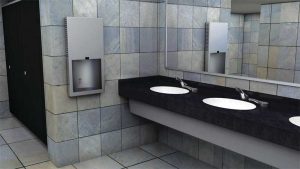Touchless accessories

Photo courtesy Bobrick Washroom Equipment, Inc.
Touchless accessories have virtually become standard to sustainable restroom design in 2019 due to their hygienic function and ability to minimize water and consumable usage.
Though automatic products are beneficial for reasons ranging from hygiene to consumable savings, energy requirements should be factored into planning. Many automatic accessories require batteries to operate, which can be another factor contributing to excess waste and energy costs. Other fixtures may need to be hardwired or require metered power source, which can contribute to electric bills.
It is also important to note there are two primary types of hands-free sensors employed in no-touch accessories: the infrared and the less-common fiber optic. Infrared sensors, despite their popularity, can result in wasted water, soap, or other consumables, as they utilize an arc-shaped beam that may not always deactivate properly. Meanwhile, fiber-optic sensors tend to be more reliable, leading to less waste and frustration by patrons.
Touchless faucets can also help improve operations—manually operated ones may result in excessive water use, and while in a rush, patrons may leave them running. Inefficient flow in the faucet’s output can compound excessive water usage.
Similarly, manual toilets and/or urinals can also contribute to unsustainable water usage. Specifiers should note, while automatic flushing systems are generally more sustainable, faulty or ineffective sensors can cause false or ineffective flushes.
Water conservation standards
Touchless operation and sensor technology aside, plumbing fixtures can have a considerable impact on water usage in the restroom.
Today, faucets are available with a variety of spray patterns and flow ranges as low as 0.5 gallons per minute (gpm). Metering faucets can also reduce water usage, as they are engineered to prevent run-on by timing out after a short time interval, reducing waste by almost 50 percent. Some faucets feature adjustable cycle times, typically between 10 and 15 seconds. They are suitable for high-traffic restrooms and those prone to vandalism.
Toilet flow rates can also contribute to sustainable operation. While the industry standard for toilets is 1.6 gallons per flush (gpf), high-efficiency toilets (HETs) can use less than 1.3 gpf. The industry standard for urinals is 1 gpf, with high-efficiency urinals (HEUs) performing at less than 0.5 gpf. Specifiers should consider flow rates in conjunction with automatic sensor types and the building occupancy to optimize operation.
To further aid water conservation, waterless urinals are available, providing superior odor containment and enhanced hygiene. In fact, waterless urinals can contribute up to four LEED points for reducing water waste. Another water-free option, composting toilets, leverage the natural process of organic decomposition to convert waste into compost, which can later be used as soil in gardens. However, waterless or ‘dry’ toilets and urinals may be more difficult or time consuming to maintain and sanitize.




